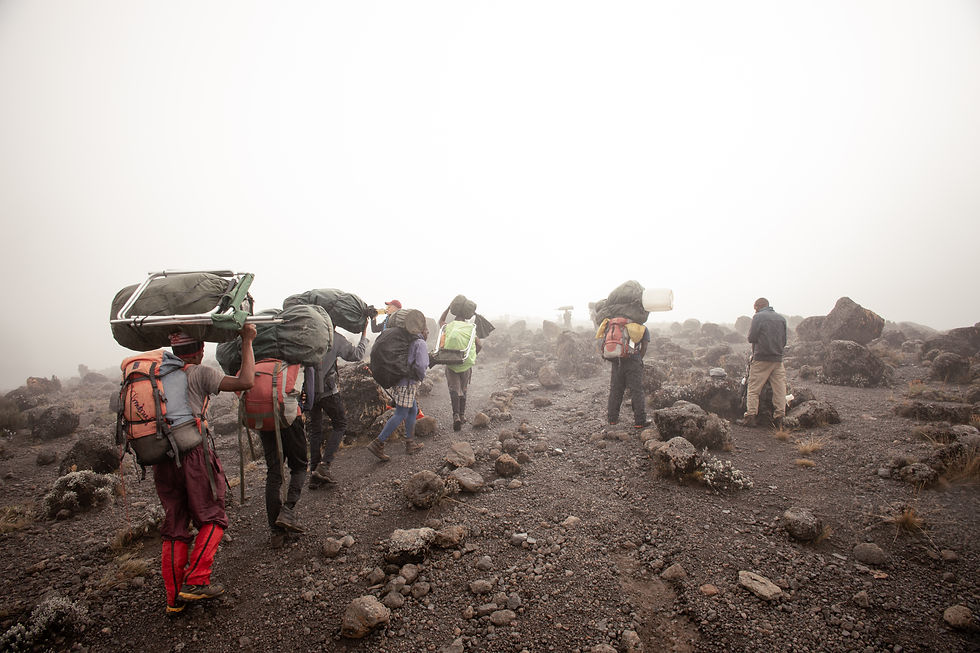A comprehensive guide to climbing Mount Kilimanjaro
- Justin Choquette
- Mar 1
- 13 min read

Nestled in the heart of East Africa, Mount Kilimanjaro stands as a majestic testament to nature's grandeur. This dormant stratovolcano, soaring to an impressive 19,341 feet (5,895 meters), beckons adventurers from around the globe to undertake the challenge of a lifetime yet one of the most fulfilling adventures you will ever embark on. For many, the decision to climb Kilimanjaro is a call to embrace adventure, challenge personal limits, and witness unparalleled vistas. The allure of standing on the "Roof of Africa" draws hikers seeking a transformative experience amid breathtaking landscapes.
Embarking on a Kilimanjaro expedition requires a little bit of planning and some physical preparation. From choosing the right route, and finding the correct company to go with to acquiring essential gear and acclimatization strategies, the journey begins long before setting foot on Tanzanian soil. Each route offers a distinct experience, ranging from the lush rainforests of the Machame Route to the stark lunar landscapes of the Northern Circuit.
The Routes
The ascent of Kilimanjaro is a multi-day trek, with varying landscapes and climates as you ascend through different ecological zones. Traversing from the vibrant rainforest, hikers encounter the heath and moorland, alpine desert, and finally, the Arctic summit zone. The gradual transition tests physical endurance and mental resilience, making the summit victory even more rewarding.
The Machame Route: This is the most popular route and this is the route I chose to do for my first trip to Kilimanjaro. It’s a seven-day trip and Machame is perfect for both beginners and experienced mountain hikers. The ascent is technically quite simple, meaning that you don't need any special equipment or climbing skills. Also, it has excellent statistics - more than 95% of the participants successfully reached the top.
Kilimanjaro offers a selection of seven distinct routes, each varying in length, difficulty, and success rates. The choice of your route hinges on factors such as budget constraints, the duration of your trip, and the expedition company you select for your journey.

1. Northern Circuit Route
2. Lemosho Route
3. Shira Route
4. Machame Route (“Whiskey” Route)
5. Rongai Route
6. Marangu Route (“Coca-Cola” Route)
7. Umbwe Route
Choosing the best route for your Kilimanjaro climb depends on your preferences and priorities. Here's a breakdown:
Highest success rate and overall best route: Lemosho and Machame routes over 7 or 8 days. These offer excellent acclimatization and a smoother summit night, making them the top choices for those prioritizing reaching the summit.
Most scenic route: Lemosho route, especially for its breathtaking views from the West.
Quietest route: Rongai route, ideal for those who prefer a less crowded climb. Note: Success rate is lower on this route.
Most challenging route: Crater camp option, providing a unique wilderness experience. Less than 1% of climbers opt for this challenging adventure.
Top Route Breakdown
Marangu: Often referred to as "the Coca-Cola route," Marangu is named after the huts available along the way where climbers can rest and purchase supplies, including a refreshing Coke. Despite its convenience, this route has a relatively low success rate due to the tendency of climbers to underestimate the challenge, opting for a quicker ascent in five days without adequate acclimatization.
Machame: Recognized as the most popular route, Machame boasts a success rate of over 95% when completed in seven days, earning it the nickname "the whiskey route" to convey its greater challenge compared to the Marangu route.
Rongai: Regarded as the easiest route, Rongai distinguishes itself by approaching Kilimanjaro from the north. While it may offer fewer scenic views and be slightly more expensive, the route is less congested, making it a favorable choice for those seeking a less busy ascent.
Shira: This route involves early high-altitude gains before converging with the Machame route. Its challenging nature and westward starting point contribute to its higher cost compared to other routes.
Lemosho: Selected for its unparalleled beauty, Lemosho stands out as the most visually appealing route up the mountain. Offering a diverse experience and significant challenge, it ranks among the pricier options available.
Umbwe: Tailored for experienced climbers seeking an extreme challenge, Umbwe involves a considerable amount of scrambling and climbing, setting it apart from the more conventional hiking routes.

COSTS
For the exact trip I did it cost around $2200 (USD) for everything.
Also here is my Friends & Family discount code: JUSTIN-KILIMANJARO 😁
It is advisable to opt for a middle-of-the-road company for two compelling reasons:
Firstly, they typically employ more qualified guides, enhancing the educational aspect of your hiking experience. Additionally, these companies are known for fairly compensating their porters, ensuring the well-being of your entire team.

Secondly, selecting a company in the middle price range
ensures that corners are not cut. Given the competitive landscape of Kilimanjaro treks, if a company's pricing seems too good to be true, it likely involves cutting corners somewhere. Considering that this is a once-in-a-lifetime adventure, prioritizing quality over cost is recommended.
Prices for Kilimanjaro expeditions vary widely, ranging from $1,000 to over $5,000 USD per person. It is advisable not to consider companies charging less than $1,900 USD, as experiences below this threshold are likely to be basic and lacking essential elements. (My trip cost around $2,200, excluding tipping, which added a few hundred dollars, but tipping is at your discretion — more details below.)
It's crucial to bear in mind that serious injuries occur on this mountain annually. To prioritize safety and overall enjoyment, investing in a reputable company with positive reviews is not only prudent but ensures a more comfortable and secure journey.
Why do you have to choose a tourism company
To climb Mount Kilimanjaro, you have to go with an operator. I won't delve too deep into this topic, but here are a few main reasons why you have to climb with a certified operator:
It's the law: To enter the park, the government has made it mandatory to go through a checkpoint to access the trailhead.
It provides jobs for the locals: Kilimanjaro offers thousands of jobs to the local people of Tanzania. From porters to guides to farmers who provide food for the expeditions, everyone relies on Kilimanjaro to survive. By going there, you are helping these humble people survive. This is rarely seen in Western culture, but these people are extremely grateful for this industry, and it's a unique thing to witness. When you arrive at Kilimanjaro, you see what I am talking about. It's pretty cool.

Safety:The hike may be easy, but it can still be deadly. If you don't know what you are doing, you could get hurt or very sick from the altitude. If you choose a company such as Altezza, you will be with guides who have extensive medical training and are well-equipped to handle any medical situation they come across.
Finding a Tour Company
Getting ready to climb Kilimanjaro means finding a good company to help you out with gear, guides, and more. Since going without porters is a no-go, choosing a reliable company is super important. With plenty of options around, here are some easy tips to help you decide:
1. Check Out Reviews
Once you know your budget, read online reviews to narrow down your choices. Reviews can give you a good idea of what other people liked or didn't like about a company. Look for details about the gear, food, and how happy clients were.
2. Think About Group Size
Ask how many people will be in your group and how many guides and porters there will be. You don't want to be in a huge group where you might not get the attention you need. Pick a company that makes sure your experience feels personal.
3. Find Out Success Rates
See how successful the company has been on the route you want to take. They can't control the weather, but a good company will do their best to help you reach the top. This tells you how committed they are to making your trek a success.
4. Choose Responsible Companies
Look for companies on the Kilimanjaro Porters Assistance Project's list. These companies follow good standards for fair treatment and ethical travel. Booking with one of these companies means you're supporting responsible travel, and it makes a big difference.
5. Check Accommodation
Don't forget to see what accommodation the company offers. Choose one that gives you a free hotel stay before and after your trek, along with pick-up and drop-off. This way, you'll get a good night's sleep before the hike and a comfy bed after your tough time on the mountain.A solid recommendation is Altezza Travel. They tick the boxes for fair treatment and responsible travel. With a bunch of treks led by friendly local guides and a reputation for treating their employees well, Altezza Travel is a reliable choice for your Kilimanjaro adventure. Pick wisely, and enjoy your climb with awesome views and memories!

Why I recommend Altezza Travel
Extensive Gear Rental Shop. Altezza Travel boasts the largest gear rental shop on Kilimanjaro, providing climbers with easy access to top-notch hiking equipment. While other operators might offer limited items like sleeping bags and jackets, the Altezza has everything, from hiking poles to appropriate footwear, sleeping bags, backpacks, you name it and it’s all top of the line gear. So basically you don’t need to bring anything with you.
Abundant Camping Equipment. Among Kilimanjaro operators, Altezza Travel stands out with the largest stock of camping equipment, ensuring both comfort and safety. With over 300 robust 4-season mountain tents and a staggering inventory of 400+ oxygen tanks, they surpass the combined resources of all other operators on Kilimanjaro. This extensive supply allows them to use oxygen not only in response to altitude sickness symptoms but also proactively during the early days of the hike for smoother acclimatization.
Double Daily Medical Check-ups. Altezza guides conduct medical checks every morning for both the crew and clients, identifying early signs of mountain sickness and adjusting hiking pace for optimized acclimatization. Individual medical cards track each participant's acclimatization progress and well-being throughout the trek.
Comprehensive Medical Kits. Altezza Travel is the sole company equipped with comprehensive medical kits covering a broad range of health issues that may arise on the mountain. There kits include over 50 types of medications for various injuries and emergencies, surpassing the standard Kilimanjaro medication provided by other operators.
Hotels. Altezza Travel owns two hotels near Mount Kilimanjaro, namely Aishi Lodge and Brubru Lodge. This means you don’t have to worry about finding accommodations when you are on your trip. Everything is taken care of.
Food. Altezza will provide you with all the food you need during the trek. Each day, we will start with a cup of coffee or tea, which will be brought to your tent before breakfast. For breakfast, you will enjoy toast, sausages, eggs, crepes, and a fruit bowl. During your hikes, you will have a tea break where the cooks will meet you halfway. They will set up a table and provide you with hot tea, coffee, cookies, and cake, giving you time to warm up and rest before continuing your hike to camp.

Once you arrive at camp, you will be greeted with a warm bowl of soup, popcorn, and cookies. For dinner, you will have a range of meals to choose from, including chicken, fish, rice, stew, pasta, fresh fruit, and vegetables. Additionally, clean drinking water and warm washing water will be provided to help you stay clean.
Guides: The guides are extremely knowledgeable and experienced especially compared to other companies. Our guide's names were Stanley and Gerald both of them have climbed Mount Kilimanjaro over 180 times over the last sixteen years. So they know what they are doing. And the entire team was extremely friendly and respectful and went out of there way to make sure we were comfortable and made it to the summit.

What to pack ( Altezza has
everything )
The beauty of going with Altezza is that you don’t have to bring anything. I have done numerous trekking trips around the world, and traveling with gear is a pain. You're always worried that it's going to get lost or your bags are overweight. Altezza has everything you need, so you literally don't need to bring anything aside from the basics. However, if you do want to bring your own gear, here is a list of things you will need.
Small backpack (25-50 liters)
Sleeping bag (comfort -10°С)
Waterproof duffel bag (≈100 liters / carried by porter)
Mountain sunglasses with UV protection (3-4 Cat.)
Hydration bag / Bladder
Trekking poles
Trekking pants
Warm fleece jacket (Recommended 2 pcs)
Membrane jacket
Hiking boots (ankle-fixing)
Membrane pants
Waterproof poncho
Headlamp (including 1 set of batteries)
Fleece Toque (in addition, balaclava is recommended)
Leg gaiters
Fleece gloves
Gloves or Mittens for summit day (comfort -15°С)
Shell pants for summit day (comfort -15°С)
Down jacket for summit day (comfort -15°C)
Thermal underwear set (Recommended 2 pcs)
Trekking sneakersMembrane pants

Top Tips for a Successful Kilimanjaro Climb
Prioritize Insurance Coverage
Ensure your travel insurance covers the entire altitude range of your Kilimanjaro trek. Many policies have restrictions, and it's crucial to verify that you'll be covered at all altitudes to avoid any issues in case of injury.
Invest Time in Pre-Trek Training
Different routes on Kilimanjaro present unique challenges, requiring physical fitness. While most trail days are manageable, substantial elevation gains and the demanding last day require good shape. Regardless of age, proper training prepares you for success. Notably, an 87 and 89-year-old both summited, emphasizing that age is no barrier with adequate preparation.
Carry Altitude Medication
Altitude affects individuals differently, making altitude medication a wise precaution. A recommended option is 250mg of Diamox, known to alleviate altitude sickness symptoms. Consult your doctor for suitable choices, considering potential side effects, like increased urination.
Opt for a Company with Included Gear
Although seasoned hikers may possess their gear, bringing it to Tanzania can be cumbersome, especially considering the need for cold-weather gear on summit night. Choose a company that provides essential gear such as hiking poles, winter gear for the summit, sleeping bags, and gaiters. While many companies offer gear, double-check to avoid surprises.
Consider a Portable Toilet
Investing extra for a portable toilet, despite its basic nature, is a worthwhile expense. The toilets at various camps can be unpleasant, making a private toilet tent a valuable addition for comfort and hygiene during the trek.
Prioritize Hydration
Staying well-hydrated is crucial for success on Kilimanjaro. Aim for at least 5 litres of water per day, carrying at least 3 liters during the day and drinking the rest in camp. Utilize a 2-3L water bladder, ensuring it's full before setting off and empty by the time you reach camp. Adequate hydration significantly improves your chances of reaching the summit.
Break in Your Footwear
If purchasing new hiking boots for the trip, ensure you break them in properly. Allow for at least one month of regular wear to prevent blisters and ensure maximum comfort during the trek. Neglecting this step may lead to painful foot conditions that can hinder your climb.
Embrace a Slow Pace
Going slow is key to successful acclimatization. Despite personal walking habits, adopting a deliberate and gradual pace is vital. Guides will stress this point — adhere to their advice. On summit night, a slower pace significantly increases your likelihood of reaching the top, emphasizing that patience pays off in the end.
Pictured is @lifeofelliott and the rest of the group.
Best Time to Climb Kilimanjaro
April-May
The onset of the rainy season spans from late March to mid-May. April is Tanzania's “coldest” period.
June-July
Rainfall gradually diminishes during this period, resulting in dry and clear conditions on Kilimanjaro. Though nights remain cold. June can provide excellent weather and you will almost get a nearly private experience because not a lot of people climb during this month. Climber numbers increase progressively, with July marking the point when most routes become notably busy.
August to September
This period boasts favourable climbing weather, featuring clear and relatively warmer days than in June/July.
October
Favorable weather conditions into mid-October, offering a unique opportunity for a less crowded Kilimanjaro trek. Towards the month's end, weather variability increases, but with proper preparation for occasional rain showers, this shouldn't pose significant challenges.
November ( this is when I went )
Embracing the "small" rainy season, November introduces rainy weather that may persist into mid-December. While temperatures drop and mist envelops the mountain, creating a more challenging and thrilling climb, the stunning views of a mist-covered Mount Kilimanjaro with its snow-capped peak make it a captivating experience.
December - January
Christmas and New Year mark the second busiest climbing season on Kilimanjaro, attracting a high influx of climbers. Although traffic is intense, there's a likelihood of rain and thick clouds at lower altitudes of the mountain.
Mid-January to mid-March
This period remains popular among climbers due to well-balanced weather conditions. Neither excessively cold nor excessively wet, the days are generally dry, with occasional rains. Rain possibilities increase in the latter half of March as the "big rains" season approaches.

Altitude Challenges
As the air thins with every step towards the summit, climbers face the challenges of high altitude. Altitude sickness becomes a formidable adversary, emphasizing the importance of a slow and steady pace, proper hydration, and acclimatization stops. Guides and porters play a crucial role, providing support and expertise to ensure the safety of the climbing party.
Sunrise at Uhuru Peak
Reaching Uhuru Peak, the highest point on Kilimanjaro, is a moment of triumph and reflection. Standing atop the snow-capped summit, the world unfolds below in a panorama of clouds, glaciers, and distant horizons. The sunrise over Africa is a breathtaking spectacle, casting hues of pink and orange across the vast expanse.

Is it safe for women?
Tanzania, in general, is considered safe for women travelers. However, as with any destination, it's essential to take common-sense precautions to ensure your safety. Here are some tips for women travelling to Tanzania:
1. Dress Modestly: Tanzanian culture values modesty in dress. While coastal areas and tourist destinations are more lenient, it's respectful to dress modestly, especially in rural or conservative areas.
2. Avoid Risky Areas at Night: Like in many places, it's advisable to avoid poorly lit or unfamiliar areas at night. Stick to well-traveled paths and use reliable transportation options.
3. Stay Informed: Keep yourself informed about local customs, traditions, and any potential risks in the areas you plan to visit. Awareness can contribute to a smoother and safer experience.
4. Use Reputable Accommodations: Choose reputable accommodations with good reviews and security measures in place. Many hotels and lodges in tourist areas prioritize the safety of their guests.
5. Transportation Safety: Use registered and reputable transportation services. Avoid hitchhiking and opt for licensed taxis or transportation provided by your accommodation.
6. Solo Travel: If you're travelling solo, let someone know your plans and keep in regular contact. Stay connected and inform someone you trust about your whereabouts.
7. Health Precautions: Take health precautions seriously, including vaccinations and malaria prophylaxis. Carry necessary medications and be mindful of food and water hygiene.
8. Respect Local Customs: Show respect for local customs and traditions. This helps you integrate better into the community and minimizes any potential misunderstandings.
9. Money Safety: Be cautious with your belongings, including money and valuables. Use secure bags and keep an eye on your belongings in crowded places.
10. Trust Your Instincts: If something doesn't feel right, trust your instincts and remove yourself from the situation. Being aware of your surroundings is crucial for personal safety.
Remember that experiences can vary, and it's essential to stay informed and adapt to your specific travel circumstances. Always consult updated travel advisories and consider reaching out to other female travellers who have visited Tanzania for firsthand insights.

Climbing Mount Kilimanjaro is more than a physical conquest; it is a journey that leaves an indelible mark on the soul. The memories of overcoming challenges, the friendships formed, and the profound connection to nature create a lasting legacy that extends beyond the summit.
Conquering Mount Kilimanjaro is not merely about reaching the pinnacle; it's a transformative odyssey that pushes boundaries and reveals the strength within. As the sun sets on the "Roof of Africa," climbers descend with a newfound appreciation for the world's wonders and the enduring spirit that drives us to explore the heights of our human potential. This is a trip I highly recommend you do once in your life.






















Comments